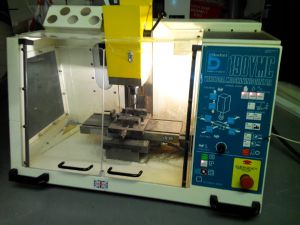Equipment/Boxford CNC Mill
Jump to navigation
Jump to search
| CNC Mill | |
|---|---|
 | |
| Model | Boxford 190VMC |
| Sub-category | CNC |
| Status | Under construction |
| Training requirement | yes |
| Owner | tgreer |
| Origin | Donation through tgreer |
| Location | Basement, Robotics/CNC area |
| Maintainers | artag, mentar |
Specs
- 8 spindle speeds 350 to 3500 rpm
- Rapid traverse rate at 100% 2000mm/min (78"/min)
- Axis travel
- X(longitudinal) 225mm (8.9")
- Y(cross) 150mm (5.9")
- Z(vertical) 140mm(5.5")
- System resolution 0.005mm
- Table dimensions 410 x 130mm(16.1" x 5.1")
- Spindle to table 202mm (7.9")
- Centre line of spindle to column 130mm (5.1")
- Table to column 5 to 130mm (0.2" x 5.1")
- Tee slots 2 x 10mm
Updates
- 10-JUL-2014 : Mill arrived, mechanics and electrics work, has what looks like a parallel pot out the back, need to research how to interface.
- 12-JUL-2014 : Connector is DB25 and almost certainly serial. It appears there is an internal g-code interpreter.
ToDo
These things need doing by somebody interested in getting the machine running. I'll get onto them eventually (artag) but it's good to involve others. However, PLEASE co-ordinate over email and in this wiki - we don't want people duplicating work or working at cross-purposes.
- Attempt to use the dos-based Boxford software linked below - assuming this just reads a file of gcode and
controls stop/start, spindle, etc. it's all we really need and we can probably reimplement under Linux
- Make the machine safe against accidental movement while debugging.
- Determine baud rate and handshaking on the serial port. Might be done by running above software, If it won't run, then try sending some harmless gcode at various baud rates and try to get it working. Could also find out how the 26450 UART is set up, if it's what's used for the external port. There are some serial patch items by the lathe. Don't lose them. Use them to help work out the necessary cable (it's apparently a null modem).
- Major cleanup and re-grease. This is an activity that historically involves leaving all the bolts on one side, where they get lost. Do NOT DO THIS. Plan the cleaning carefully, only leave things in parts if there's no other possiblity, and then keep all the parts in one box, partitioned and labelled so they can still be restored after several months, perhaps by a different person. Take photos and link them to this wiki.
More info
- (Mailing list post)
- Spindle taper is a Coventry quick-change ref Or possibly EasyChange. maker examples
- Reliable Manual source (cheaper would be nice)
- Possible manual source
- V5 Programming Manual
- Photos by Russ
Boxford are said to be unhelpful regarding support and will only talk to educational users. However, they do publish spares lists and software updates.
Needed
- A base/stand (ideally, a sturdy cupboard or machine cabinet like this
- More toolholders
- Investigate g-code generation software and the interface
- Further manuals or other information
Not needed
- People who take it apart and leave it in pieces
- Experimenting carelessly. Consider it in the same light as the laser cutter, the robot arm etc. : if you want to work on it, join the official maintainers group and cooperate.
Troubleshooting
- The cutter appears to spin off-centre
- When slotting in the collet make sure to put it the right way in as it's got a notch which will only go in fully when aligned